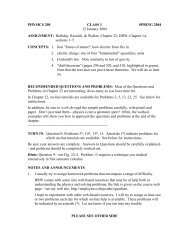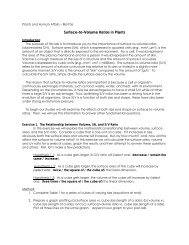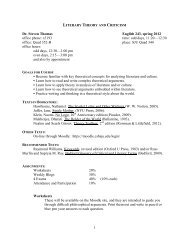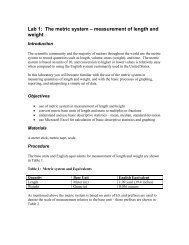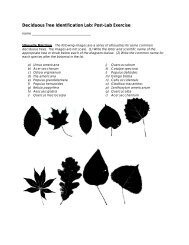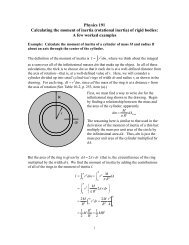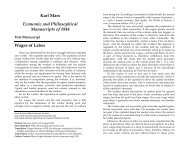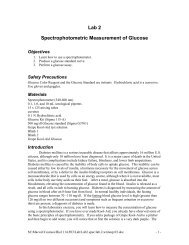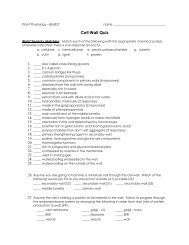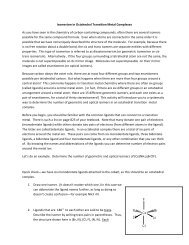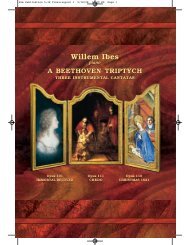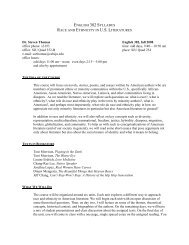Lab Common Woody Plants - Employees Csbsju
Lab Common Woody Plants - Employees Csbsju
Lab Common Woody Plants - Employees Csbsju
Create successful ePaper yourself
Turn your PDF publications into a flip-book with our unique Google optimized e-Paper software.
Plant Taxonomy – Biol308<strong>Common</strong> <strong>Woody</strong> <strong>Plants</strong> of Central MinnesotaObjectives: upon completion of today's lab you should be able to:1. identify approximately 30 species of deciduous tree and shrubs (see list below)2. describe the difference between a tree, shrub and herb3. use appropriate terminology to describe the vegetative characteristics of woody plantssuch as (a) leaf shape; (b) leaf margins; (c) leaf arrangement; and (d) stem structureAssignment Due Today:• Wear clothing appropriate for going into the field and bring water, sun block and bugrepellent• Notebook and 10 pressed plants<strong>Plants</strong> to Know: We will locate and identify the following species that will be "fair game" on thePTK quiz/exam. (Other species may also be included). To help prepare for the quiz, completethe post-lab assignment.ACERACEAE - Maple familyAcer rubrum Red mapleAcer saccharum Sugar mapleAcer negundo Box elderANACARDIACEAE - Cashew FamilyRhus glabra Smooth sumacBETULACEAE - Birch FamilyBetula nigra River birchBetula papyrifera White or paperbirchOstrya virginiana Ironwood,HophornbeamBIGNONIACEAE - Bignonia FamilyCatalpa speciosa - Northern catalpaCAPRIFOLIACEAE – Honeysuckle FamilySambucus pubens Red elderCORNACEAE - Dogwood FamilyCornus sp. - DogwoodFABACEAE - Bean or Pulse FamilyGleditsia triacanthos Honey locustGymnocladus dioica Kentuckycoffee treeRobinia pseudoacacia Black locustFAGACEAE - Beech FamilyQuercus alba White oakQuercus bicolor - Swamp white oakQuercus macrocarpa Bur oakQuercus rubra (= Q. borealis)Northern red oakGROSSULARIACEAE - Gooseberry FamilyRibes sp. - Gooseberry, currantHIPPOCASTANACEAE - Horsechestnut FamilyAesculus glabra - Yellow or OhiobuckeyeJUGLANDACEAE - Walnut family
Juglans nigra Black walnutJuglans cinerea ButternutOLEACEAE - Olive familySyringa vulgaris <strong>Common</strong> lilacFraxinus pensylvanica Green ashROSACEAE - Rose FamilyAmelanchier sp. Juneberryserviceberry, shadbush, SaskatoonPrunus serotina - Black cherryPrunus virginiana – ChokecherryRUTACEAE - Citrus FamilyZanthoxylum americanum PricklyashSalix sp. – WillowPopulus deltoides CottonwoodPopulus grandidentata Largetoothed aspenPopulus tremuloides Quaking aspenTHYMELAEACEAE - Mezereum FamilyDirca palustris LeatherwoodTILIACEAE - Linden FamilyTilia americana Basswood, LindenULMACEAE - Elm FamilyCeltis occidentalis HackberryUlmus americana - American elmUlmus rubra Slippery elmSALICACEAE - Willow FamilyIntroduction<strong>Woody</strong> plants can be roughly divided into two groups: (a) the evergreens or conifers, and (b)deciduous or broadleaf trees. The broadleaf trees, like oak and maple, have deciduous leaveswhich are shed at the end of the growing season. These trees also typically produce flowers,though they may go unnoticed because they are often green and not very showy. In fact, alarge percent are wind-pollinated in the spring. There are about 80 species common trees andshrubs that grow on the campus of St. John's University. When the settlers arrived in centralMinnesota they found a landscape dominated by deciduous forest with scattered wetlands andlakes (see Presettlement Vegetation Map). The deciduous forest is the predominant vegetationtype in this area and is well-represented on both the St. John's and St. Benedict's campuses. Thepurpose of today's lab is to learn to identify the common trees & shrubs in the deciduous forestson our campuses. This exercise will provide an opportunity to identify some of these plants.Broadleaf IdentificationIn general, to identify an unknown woody plant you will need to be able to answer thefollowing questions (in approximately the indicated order):1. Is it a tree or shrub?Although this may seem obvious, it's not. Typically, trees have a single stem and are tallwhereas shrubs have multiple stems and are short. To complicate matters, some trees arerelatively short (e.g., Ironwood, Slippery elm), while others may form multiple sucker shoots fromnear the base (e.g., Basswood) or may form rather dense thickets by sprouting fromunderground roots (e.g., Black locust). Tree seedlings may appear shrub-like.2. Is the leaf blade comprised of one piece or is it divided into sections (leaflets)?To provide a little background - leaves typically have a flat blade that is either attacheddirectly to the stem or is attached via a stalk called a petiole. As an aside, some leaves may
also have small, leafy appendages called stipules at the base of the leaf stalk. If the leaf has asingle blade that is undivided it is termed "simple." In contrast, the blade of a compound leaf isdivided into sections (called leaflets).It's not always easy to determine whether or not a leaf is simple or compound. Fortunately,there is one foolproof trick - look for a bud, which is an embryonic or immature shoot. There is abud at the junction of the leaf with the stem (axil). Thus, a leaf has a bud at its base but a leafletdoes not. <strong>Plants</strong> such as Honey locust and leatherwood may provide a little confusion since thebase of their leaves are swollen and cover the bud so it is not visible unless you remove the leaf.Finally, another trick to distinguish between compound and simple leaves is to look for thetextural and color difference between the stem and leaf.3. How are the leaves attached to the stem?Are the leaves attached singly to the stem (alternate), in pairs (opposite), or in groups of morethan two (whorled)? Like distinguishing trees from shrubs, this simple feature can also bedeceiving. For example, the leaves of some plants are borne on short spur (or dwarf) shoots. Itwill appear as though these plants have whorled attachment when in reality, the spur shoot is acompressed stem with alternate attachment. How can you tell? Look are the arrangement ofthe spur shoots themselves; they will alternate along the stem. Another method to determineleaf attachment is to look at the branching pattern of the tree. Since the branches come fromthe buds at the base of the leaves, the pattern of branching provides an indication of how thebuds were positioned. A mnemonic to remember the common trees & shrubs with oppositeleaves is "MADCap Horse" (or MADHoney Buck), which stands for Maple, Ash, Dogwood, Cap =Caprifoliaceae or honeysuckle family, which are mostly shrubs, and horsechestnut or buckeye.Descriptions of Some <strong>Common</strong> Trees & ShrubsAsh (Fraxinus) - The ashes can be recognized by their compound, opposite leaves and thecharacteristic winged fruits. Two species commonly occur in our area - green ash (F.pensylvanica) and black ash (F. nigra). Baseball bats are traditionally made from ash and thewood of black ash is used for making baskets.Basswood (Tilia americana) - Basswood or linden or lime can be recognized by the relativelylarge, heart-shaped leaves that are usually lop-sided at the base. Basswood often growsintermixed with maples. Basswood often occurs in clumps of several stems. The wood is soft andgood for carving and the flowers are fragrant and make a great honey.Birches (Betula) - This group of trees is easily recognized by their beautiful bark. The leaves aresimple, alternate and toothed. The flowers occur in clusters called catkins. <strong>Common</strong> species ofbirch include white or paper birch (B. papyrifera), river birch (B. nigra), and yellow birch (B.alleghaniensis).Black Locust (Gleditsia triacanthos) - This is a small tree that tends to creep and colonize anarea. It is characterized by the alternate, compound leaves with paired, stipular spines. Therelatively-large white flowers are produced in showy clusters in the early summer and are edible.Buckeye (Aesculus) - Buckeyes are named for the appearance of their distinctive seeds whichare produced in a spike-covered pod that splits open. The leaves are opposite and palmatelycompound. Horsechestnut is a related species that is planted as an ornamental. The seeds ofbuckeye and horsechestnut should not be roasted over an open fire - they are not the ediblechestnuts.
Catalpa (Catalpa speciosa) - Cigartree is another name for this tree with long, thin brown pods.These trees have large heart-shaped leaves and beautiful white and purple flowers when itblooms in midsummer.Cherry (Prunus sp) - Cherry is a common name for woody plants in the genus Prunus thatproduce a stone fruit. These plants typically have simple, alternate leaves. At the junction of theleaf blade with the stalk there is usually a pair of glands. The flesh of the fruits can be used tomake jelly but the seed and vegetative parts shouldn't be eaten because they contain cyanideproducingchemicals. Chokecherry (P. virginiana) is a shrub with that leaves are typically widestabove the middle in comparison to black cherry (P. serotina) that is a tree with leaves that arewidest below the middle.Dogwoods (Cornus) - Dogwoods are shrubs with simple opposite leaves that have verydistinctive veins that run along the margin of the leaf to the tip. When you rip open a leaf theveins you will see cobwebby filaments. Dogwoods produce a berry for a fruit.Elms (Ulmus) - The elms are trees with alternate, simple and toothed leaves. The base of theleaves is lopsided. The fruits are flat, round and winged. Until it was decimated by a fungaldisease, the American elm (U. americana) was the predominant street tree because it has a "Yshape"that when planted on both sides of a road forms a lovely green cathedral. Anothercommon elm is slippery elm (U. rubra) which is named for its mucilaginous inner bark, not itsrough sandpapery leaves.Elder, Red (Sambucus pubens) - These plants are understory shrubs or small trees. They haveopposite (recall MADC(aprifoliaceae)AP Horse), compound leaves. The stems are relativelyfragile because of the large soft pith. The flowers are white in the spring and ultimately yield redberries.Gooseberry (Ribes) - This is a genus of primarily forest shrubs. The leaves are typically palmatelylobedand toothed. The plants may be armed with spines (gooseberries) or not (currants). Thefruits are edible and typically used in jams and jellies.Hackberry (Celtis occidentalis) - Perhaps the most distinctive feature of this tree is its warty bark.The leaves are simple, alternate, toothed and have a lopsided base. The fruits are hard but theouter coating can be scraped off and eaten. Witches broom's, which are areas of excessivebranching caused by a mite that infects the terminal bud of a branch, often occur on thesetrees.Honey Locust (Gleditsia triacanthos) - These trees have alternate compound leaves. Some ofthe leaves may are singly compound while others may be doubly-compound. Our nativevariety has numerous thorns on the stem. However, the cultivated varieties have been selectedfor being unarmed. They produce male and female flowers on separate plants. The femalesproduce long brown pods.Ironwood (Ostrya virginiana) - Ironwood is a small tree that grows in the understory of maples,basswood and oaks. They get their name from their dense wood that makes good fence posts.Another name for this tree is hop hornbeam which refers to the clusters of fruits that arereminiscent to hops used in brewing. The bark of these trees is finely-lined and seems to twist likea barber-pole.
Juneberry (Amelanchier sp.) - These small trees or shrubs are also called shadbush andserviceberry. They produce white flowers early in the spring before the leaves fully develop. Theleaves are ovate and toothed. The fruits are red to purplish and are actually similar in structureto an apple. They are edible fresh from the tree or make wonderful jams and pies.Kentucky Coffee tree (Gymnocladus dioica) - Presumably the early settlers made a coffeesubstitute from the hard seeds of this tree. Stout twigs with a salmon colored pith, largecompound leaves and stubby brown pods make this tree easy to recognize.Leatherwood (Dirca palustris) - This shrub is an indicator of moist rich soil and often occurs withmaples and basswood. The leaves are egg-shaped and the base of the leaf forms a protectivecap that covers the bud. The bark is very tough and fibrous and was used for lacing by nativeAmericans. The sap of the tree may cause a dermatitis in sensitive individuals.Lilac (Syringa vulgaris) - This commonly-planted shrub is immediately familiar in the late springwhen it begins to flower. It has opposite, heart-shaped (cordate) leaves. The fruits aredistinctive capsules.Maples (Acer) - The maples are characterized by having opposite leaves and a pair of wingedseeds. There are several common maples on campus included sugar maple (A. saccharum),Norway maple (A. platanoides), Amur maple (A. ginnala), box elder (A. negundo), and silvermaple (A. saccharinum). All the maples can be tapped to make maple syrup, but sugar mapleis preferred because it has a higher sugar concentration.Oaks (Quercus) - The oaks are trees with simple, alternate and lobed leaves. There are twogroups of oaks - the red oaks and the white oaks. The red oaks, which includes northern red oak(Q. rubra) and northern pin oak (Q. ellipsoidalis), have sharp pointed lobes and take two yearsto mature acorns. The white oaks such as white oak (Q. alba), swamp white oak (Q bicolor),and bur oak (Q. macrocarpa), have rounded lobes and mature acorns in a single season. Thewood is valuable for lumber. White oak is used extensively in barrel making.Poplars (Populus) - This group of trees has simple, alternate leaves with a flattened leaf stalk(petiole). The flowers are produced in catkins. The buds are often resinous. There are severalspecies of Populus in our area including quaking or trembling aspen or popple (P. tremuloides),bigtooth aspen (P. grandidentata), cottonwood (P. deltoides) and balsam poplar (P.balsamifera).Prickly ash (Zanthoxylum americana) - These shrubs have paired thorns at the base of each leafand can form dense thickets that can be nearly impenetrable. The leaves are alternate andcompound. The fruit has a slight citrus odor reflecting its close evolutionary relationship. Thewood of the plant was chewed for toothaches because it contains salicylic acid, a precursor toaspirin.Sumac (Rhus) - These shrubs usually grow along roadsides and in other disturbed areas. Theyhave alternate, pinnately compound leaves. They are one of our most beautiful fall plants; theleaves turn a beautiful scarlet color. The red clusters of fruits can be used to make a lemonadesubstitute. Two common species on campus are smooth sumac (R. glabra) and staghorn sumac(R. typhina). They look similar with the exception that the twigs of the latter are covered withhairs.
Walnuts (Juglans) - These trees have alternate compound leaves. The pith or core of the twigs isbrown with partitions. The wood is valuable for woodworking and used for gunstocks andfurniture. There are two species - Black walnut (J. nigra) and butternut (J. cinerea). They looksimilar except that black walnut twigs and leaves are less hairy and they have round fruits whilebutternut twigs are hairy and the fruits are oblong. The fruits are covered by a greenish husk thateventually dries up and turns brown. Once this is removed it exposes the hard nut inside. Thenuts are loved by squirrels and are very tasty if you have the patience to crack them open.Willows (Salix) - These woody plants are often shrubs or small trees. They have simple, alternateleaves and usually distinctive stipules (leafy appendages at the base). The flowers are in catkinsand make the distinctive "pussy willows." The bud are covered by only a single scale. Theyfrequently grow in a wet area.<strong>Lab</strong> ActivityDuring today's lab we will walk around campus looking for representative samples of the treesin the list above. We will go out rain or shine so dress appropriately. Out in the field I will describethe key characteristics of these species and provide other information (edibility, uses, etc.) asappropriate. We will use a dichotomous key to to identify several specimens. You will may wantto bring a notebook and pen to take notes about each species that we find.References• Clements, Frederic E., C. Otto Rosendahl, Frederic K. Butters. 1912. Minnesota Trees andShrubs. The University of Minnesota Press, Minneapolis.• Cope, EA. 2001. Muenscher's Keys to <strong>Woody</strong> <strong>Plants</strong>. An Expanded Guide to Native andCultivated Species. Cornell University Press, Ithaca.• Coombes, Allen J. 1992. Trees. Eyewitness Handbooks. Dorling Kindersley, Inc., NewYork.• Farrar, John Laird. 1995. Trees of the Northern United States and Canada. Iowa StateUniversity Press, Ames.• Rathke, DM. 1995. Minnesota Trees. Minnesota Extension Service, University of Minnesota,Minneapolis.• Rosendahl, Carl O. 1955. Trees and Shrubs of the Upper Midwest. University of MinnesotaPress, Minneapolis.• Severin, C. 1980. A Key to the <strong>Woody</strong> <strong>Plants</strong> of Minnesota. St. Mary's College Press,Winona (MN).• Stidd, BM & RD Henry. 1995. Key to <strong>Common</strong> <strong>Woody</strong> Landscape <strong>Plants</strong> in the Midwest.Stipes Publishing, Champaign, IL.• Stephens, H. A. 1973. <strong>Woody</strong> <strong>Plants</strong> of the North Central Plains. The University Press ofKansas, Lawrence.• Symonds, George W. D. 1963. The Shrub Identification Book. William Morrow &Company, New York.• Symonds, George W. D. 1958. The Tree Identification Book. Quill, New York.• Tekiela, S. 2001. Trees of Minnesota Field Guide. Adventure Publications, Cambridge(MN).Web Resources• Saupe, S. Checklist of the trees and shrubs of St. John's University & the College of St.Benedict• Saupe, S. Some common trees and shrubs of St. John's (pdf)• Minnesota Trees (http://www.mntrees.org/)
• Identifying Trees <strong>Common</strong> in Minnesota Landscapes(http://www.mntca.org/Reference_manual/Tree_info/Minnesota_Tree_Index.htm)• Online Interactive Key to the <strong>Woody</strong> <strong>Plants</strong> of Minnesota - G Weiblen & N Deacon.(http://geo.cbs.umn.edu/treekey/navikey.html)• Dichotomous Tree Key - Environmental Education for Kids.(http://www.dnr.state.wi.us/org/caer/ce/eek/veg/treekey/index.htm)• Dendrology at Virginia Tech Keys (http://www.cnr.vt.edu/dendro/dendrology/idit.htm)• Trees & Shrubs of Iowa State University(http://project.bio.iastate.edu/trees/campustrees/ISU_trees.html)• Fact Sheets for 680 Trees (http://hort.ifas.ufl.edu/trees/)Supplies• dichotomous keys to woody plants• hand lens



